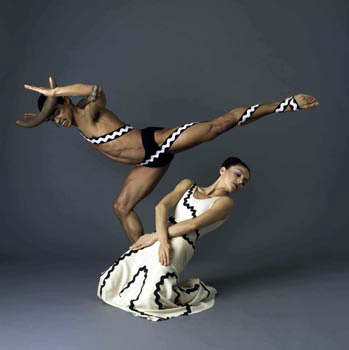Martha in the New Millennium
Circe, Herodiade, Errand into the Maze, The Maple Leaf Rag
Martha Graham Dance Company
City Center
New York, NY
April 14-25, 2004
by
Meital Waibsnaider
copyright
© 2004 by Meital Waibsnaider
published 11 April 2004
 As
pre-ballet six-year-olds, one of my favorite childhood friends and I would
create lavishly over-the-top melodramas and perform them for our siblings
and parents. If anyone dared to interrupt our performance with snickers
or comments, we threatened to stop. More than just a little bit of this
spirit thrives in the works of Martha Graham.
As
pre-ballet six-year-olds, one of my favorite childhood friends and I would
create lavishly over-the-top melodramas and perform them for our siblings
and parents. If anyone dared to interrupt our performance with snickers
or comments, we threatened to stop. More than just a little bit of this
spirit thrives in the works of Martha Graham.
The first dance on the four-piece Program B at City Center was Circe, Graham’s 1963 rendition of the Ulysses tale in which he meets the seductive sorceress who turns his traveling partners into beasts, and shows him the darker side of humanity that he must struggle to overcome. Outfitted in a golden V-neck leotard, the beautiful Katherine Crockett proved an enchanting temptress at the April 17th performance.
Like all Graham dancers, Crockett is impeccably trained and toned. And, like many Graham dancers, she and her colleagues pose impressively as the primal archetypes in which they are cast. But beyond their technique, there is little substance to bolster this theatrical posing. What was once groundbreaking about the psychological depth of Graham’s work now appears dramatically simple and borderline silly.
The oldest work on the program, Herodiade premiered in 1944 and featured two characters—A Woman and Her Attendant. Less dramatic than Circe in that neither woman was made to prance like a deer at the whim of a sorceress, Herodiade depicted the Woman’s trying internal quest and Her Attendant’s frustratingly thwarted attempts to reach out to her.
Herodiade was most impressive in its depiction of a human conversation through movement. Every time Elizabeth Auclair, in the role of the Attendant, performed a deep contraction with her arms reaching towards the Woman, Miki Orihara at this performance, I sensed a deep longing and understood that I was witnessing one of the most palpable of silent conversations. In the final moments of the dance, Auclair stripped Orihara of her detailed purple gown, leaving her in a flowing white dress. Auclair then presented a long black cloth that was previously draped on a bone-like sculpture throughout the piece. As the lights faded, Orihara engulfed herself in the black cloth, showing only a sliver of her haunted face.
In Errand into the Maze, which premiered in 1947, Fang-Yi Sheu imbued every step she danced with such meaning and freshness that she managed to not make Graham’s choreography appear like historical dancing. Sheu’s fluid musicality and expressive, yet subtle, looks truly conveyed a warrior’s solid and steady victory over the Creature of Fear (thus described in program notes). Like a seasoned actress, Sheu helped us to imagine that the steps she performed flowed directly from her heart and mind, and out through her limbs. She was one of the few company dancers who seemed intrinsically comfortable performing Graham’s dated material.
Maple Leaf Rag, Graham’s last work that premiered in 1990, finally brought her revolutionary dances into the present day. Set to a medley of upbeat Scott Joplin music, the piece proved that Graham could laugh at her almost militant style while at the same time blend it seamlessly with popular ballroom steps.
A cadre of eighteen dancers, outfitted by Calvin Klein in light-colored unitards, which the women sometimes covered with ankle-length skirts that fell from their waists, alternately performed jazz runs and earthy Graham hinges and contractions. There was much partnering of the typical ballroom dance variety, but also less dainty modern lifts, in which women bent their knees in a turned-out position, displaying no such modesty. Much to the audience’s amusement, one woman repeatedly crossed the stage in a ridiculously long white skirt in an endless procession of “woe’s me” turns. She might as well have been a stand-in for all the women characters of the earlier dramatic pieces.
Maple Leaf Rag was the only piece on the program to not take itself so seriously. It proved that Graham possessed a sense of irony generous enough to compare her work to other styles, yet smart enough to grasp just where she fit in.
Photo: Christophe Jeannot and Alessandra Prosperi in Errand into the Maze Photo by John Deane
Originally
published:
www.danceviewtimes.com
Volume 2, Number 14
April 19, 2004
Copyright
©2004 by Meital Waibsnaider
|
|